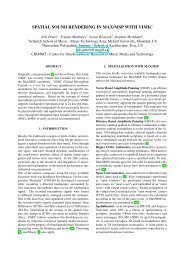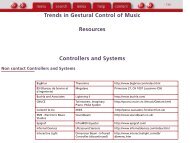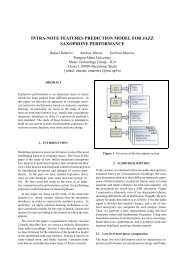Basic Mensural Notation Reference
Basic Mensural Notation Reference
Basic Mensural Notation Reference
You also want an ePaper? Increase the reach of your titles
YUMPU automatically turns print PDFs into web optimized ePapers that Google loves.
————————— DIRECTED PROGRESSIONS —————————<br />
• In counterpoint, when an imperfect consonance (3rd, 6th) moves to a perfect consonance<br />
(unison, 5th, octave), the imperfect consonance should be performed as major or minor in<br />
order to approach the perfect consonance with the smallest movement (e.g., a 6th expanding<br />
to an octave should be major, a 3rd contracting to a unison should be minor)<br />
• Sharps and flats can be performed to ensure this type of “closest approach”<br />
6 - 8<br />
;<br />
3 - 1<br />
;<br />
or<br />
3 - 5<br />
————————— MELODIC LEADING TONES —————————<br />
• The “returning note” melodic phrases re ut re, sol fa sol, and la sol la should be performed<br />
with a sharp leading tone (raising the lower neighbor note by a semitone)<br />
• Such melodic phrases often appear in ornamented forms, which require the same sharpening<br />
;<br />
;<br />
;<br />
;<br />
6<br />
6 - 8<br />
;<br />
;<br />
3 - 5<br />
;<br />
;









